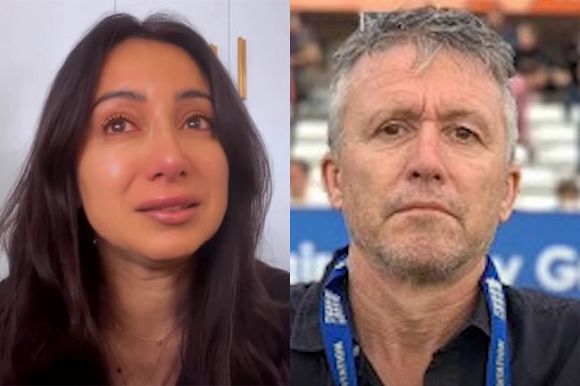If Creative Australia thinks it’s reducing the risk of losing public support by cancelling Khaled Sabsasi, surely the question is, who is this “public” it is worrying about? Rosemary Sorensen reports.
THIS WEEK, U.S. President Donald Trump virtually elected himself chairman of the Washington D C John F Kennedy Center for the Performing Arts (The Kennedy Center), forcing its president immediately to resign.
The Kennedy Center is ‘revered’ as embodying ‘the intersection of American culture and government support to the arts … an emblem of artistic aspiration’, wrote one commentator about this unprecedented Trumpian assault on the independence and quality of artists, administrators, and cultural institutions.
Detailing what Trump’s takeover might mean not just for America but globally, the commentator goes on to ponder:
‘If a figure as influential as the Kennedy Center can drastically curb certain forms of art, might that embolden similar moves elsewhere?’
We didn’t have to wait long for an answer to that.
Five days after Creative Australia announced that Lebanese-Australian artist Khaled Sabsabi had been chosen as Australia’s representative for the Venice Biennale in 2026, a statement was released reversing that decision:
‘The Board believes a prolonged and divisive debate about the 2026 selection outcome poses an unacceptable risk to public support for Australia’s artistic community and could undermine our goal of bringing Australians together through art and creativity.’
Whoever wrote that mealy-mouthed, pathetic, irresponsible, grotesquely inadequate justification for an offensive withdrawal – humiliating an artist – ought to be ashamed.
Creative Australia CEO Adrian Collette had spoken about how proud they all were to showcase Sabsabi and curator Michael Dagostino — director of the University of Sydney’s Chau Chak Wing Museum.
Collette said the selected project was going to reflect “the diversity and plurality of Australia’s rich culture, and will spark meaningful conversations with audiences around the world”.
That’s not going to happen now — at least not at the Biennale. Sabsabi and Dagostino have vowed to find a way to present the work they were planning for the Biennale “and will seek community support to make this happen”.
The right thing to have done in response to political interference based on “public” backlash – which was, in fact, yet again, defamatory misinformation in Murdoch newspapers – would be to state that this decision was forced onto the board of Creative Australia, thus destroying their independence and integrity.
But that response would be revolutionary. And, as we’ve witnessed again and again, cultural institutions do not stand up in such a way. From theatre companies to state libraries, to orchestras, who among them has spoken out honestly, courageously and with conviction when vicious lobbying targets artists, journalists, and writers?
Just one week ago, Sabsabi, who came to Australia as a child with his Lebanese family in 1978, told The Guardian that he was surprised to be chosen.
Indeed, it was a bold and admirable choice, because Sabsabi’s video art has provoked simplistic criticism, culminating in the scenario that has become all too familiar when a Liberal Senator Claire Chandler popped up in Question Time on Thursday to link Sabsabi to antisemitism.
Using an irresponsible and accusatory tone she asked:
“With such appalling antisemitism in our country, why is the Albanese Government allowing a person who highlights a terrorist leader [referring to a video installation that included images of the assassinated Hezbollah leader Hassan Nasrallah] in his artwork to represent Australia on the international stage at the Venice Biennale?”
The answer to that shouted question ought to have been, Well, Senator Chandler, why do you think an artist might do that? Tell us about the artwork you are condemning.
But no – as with the stand-up-and-shout condemnation of academic Randa Abdel-Fattah for something she said during a speech at a conference – it’s enough for a politician to grab a single image or sentence to make an accusation of antisemitism, and almost without pause, the Albanese Government reacts by punishing the artist or academic.
If Creative Australia thinks it’s reducing the risk of losing public support by brusquely cancelling Khaled Sabsasi, surely the question is, who is this “public” it is worrying about?
A politician who hasn’t seen the art? A newspaper journalist making defamatory claims? Clamorous comments on social media websites owned by a fascist?
Or is it some unnamed public, “Australians”, those people once referred to by Scott Morrison as the quiet ones — with the loudest voices?
As for the well-heeled managers of our cultural institutions – who oversee the worthy rhetoric about diversity and inclusiveness, innovation, and creativity – we now see them for what they are.
And, how poorly prepared and equipped they are for this full-on onslaught against diversity, inclusiveness, innovation, and creativity.
Revolutions never start in the deep-carpeted office of the director of a cultural institution. They start in cafes, backrooms and dusty halls. And, when enough people say “enough”.
And, when those appointed to boards – as representatives and spokespeople, as guardians of the rights and the freedoms of artists, journalists, writers, and art workers – recognise their complicity in crushing dissent and condemn it.
Rosemary Sorensen is an IA columnist, journalist and founder of the Bendigo Writers Festival.
Support independent journalism Subscribe to IA.












